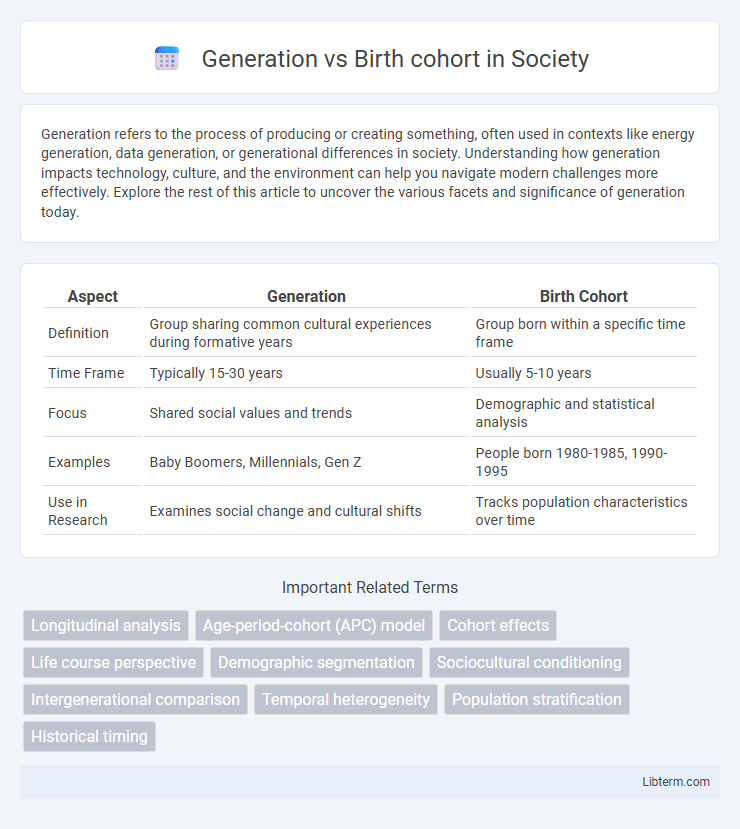Generation refers to the process of producing or creating something, often used in contexts like energy generation, data generation, or generational differences in society. Understanding how generation impacts technology, culture, and the environment can help you navigate modern challenges more effectively. Explore the rest of this article to uncover the various facets and significance of generation today.
Table of Comparison
| Aspect | Generation | Birth Cohort |
|---|---|---|
| Definition | Group sharing common cultural experiences during formative years | Group born within a specific time frame |
| Time Frame | Typically 15-30 years | Usually 5-10 years |
| Focus | Shared social values and trends | Demographic and statistical analysis |
| Examples | Baby Boomers, Millennials, Gen Z | People born 1980-1985, 1990-1995 |
| Use in Research | Examines social change and cultural shifts | Tracks population characteristics over time |
Defining Generations and Birth Cohorts
Defining generations involves grouping individuals born within a specific time frame who share common cultural experiences and societal influences, often spanning 15 to 20 years. Birth cohorts refer specifically to people born in the same year or range of years, allowing for precise demographic and health studies. While generations capture broad social trends, birth cohorts provide detailed longitudinal data pivotal for epidemiological and sociological research.
Key Differences Between Generations and Birth Cohorts
Generations refer to groups of people born within a roughly 15- to 20-year period, shaped by shared cultural, social, and historical experiences influencing collective behaviors and attitudes. Birth cohorts represent individuals born in the same calendar year or narrow range of years, analyzed primarily for demographic or epidemiological trends without necessarily implying shared experiences beyond birth timing. The key difference lies in generations emphasizing cultural identity and societal impacts, while birth cohorts focus on chronological grouping for statistical and analytical purposes.
Historical Context: How Generations Are Shaped
Generations are shaped by the unique historical events and cultural shifts occurring during their formative years, influencing shared values, behaviors, and worldviews. In contrast, birth cohorts group individuals born in the same time period without necessarily accounting for the distinct social or economic conditions impacting them. Understanding these historical contexts is essential for analyzing generational differences beyond mere age brackets or timelines.
Demographic Boundaries: Generation vs Birth Cohort
Demographic boundaries between generations and birth cohorts differ fundamentally in scope and definition. Generations encompass broader social and cultural time spans, reflecting shared experiences and values across multiple birth cohorts, while birth cohorts refer to specific groups born within a defined period, typically a single year or range of years. Understanding these distinctions is crucial for accurate demographic analysis, enabling precise tracking of population changes and trends over time.
Cultural Significance of Generational Labels
Generational labels like Baby Boomers, Millennials, and Generation Z carry cultural significance beyond mere birth years, encapsulating shared experiences, values, and societal influences that shape collective identity. These labels influence marketing strategies, political discourse, and social research by highlighting distinctive attitudes and behaviors linked to historical events and technological advancements. Understanding generational cohorts helps decode cultural shifts and intergenerational dynamics within societies.
Methodological Approaches to Studying Birth Cohorts
Methodological approaches to studying birth cohorts center on longitudinal designs that track individuals born in the same period to identify developmental trends and societal changes. Researchers employ statistical modeling techniques such as age-period-cohort analysis to disentangle generational effects from temporal influences. Advanced data collection methods, including retrospective surveys and administrative record linkage, enhance the accuracy of cohort comparisons across demographic, socioeconomic, and health indicators.
Generational Influence on Social Trends
Generational influence on social trends reflects how shared experiences during formative years shape collective behaviors and values within birth cohorts. Distinct generational identities, such as Millennials or Gen Z, drive shifts in technology adoption, cultural norms, and political engagement due to unique socioeconomic and historical contexts. Understanding generational impact enables targeted marketing strategies and informs policymaking by anticipating evolving social dynamics tied to cohort-specific attitudes.
Challenges in Comparing Generations and Birth Cohorts
Comparing generations and birth cohorts presents challenges due to overlapping social, economic, and technological influences that shape distinct experiences within similar age groups. Variability in definitions and time spans used to categorize generations or cohorts leads to inconsistent findings and complicates longitudinal studies. Measurement biases and retrospective data collection further hinder accurate comparisons, making it difficult to isolate generational effects from historical context or life stage variations.
Implications for Policy and Research
Understanding the distinctions between generation and birth cohort is crucial for designing effective policies and research frameworks. Generation analysis captures shared cultural and social experiences influencing behavior across various birth cohorts, while birth cohort studies focus on individuals born in the same time period to identify age-specific effects and life course trends. Policymakers and researchers benefit from integrating both approaches to address population health, social inequality, and economic challenges with precision and contextual relevance.
Future Perspectives on Generational Classification
Future perspectives on generational classification emphasize the integration of dynamic birth cohort data with evolving social, economic, and technological contexts to refine generational boundaries. Advances in big data analytics and machine learning enable more precise identification of shared experiences and behaviors across overlapping cohorts. This approach shifts the focus from static birth year definitions toward a multidimensional model capturing diverse life course trajectories and cultural influences.
Generation Infographic

 libterm.com
libterm.com